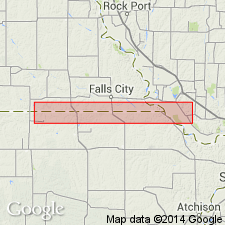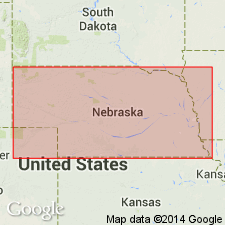
- Usage in publication:
-
- Caneyville shale member
- Modifications:
-
- Original reference
- Dominant lithology:
-
- Shale
- Sandstone
- AAPG geologic province:
-
- Forest City basin
- Nemaha anticline
Summary:
Pg. 9. Caneyville shale. 17 feet thick, underlies Greyhorse [Grayhorse] limestone and overlies Nebraska City limestone, all included in Pony Creek shale formation of Wabaunsee group. Top part of Caneyville is gray and shaly; middle and lower parts shaly and sandy, with plant leaves. Age is Late Pennsylvanian (Virgil).
[Origin of name not stated.]
Source: US geologic names lexicon (USGS Bull. 896, p. 334); GNC KS-NE Pennsylvanian Corr. Chart, sheet 2, Oct. 1936.

- Usage in publication:
-
- Caneyville shale member
- Modifications:
-
- Overview
- AAPG geologic province:
-
- Cherokee basin
Summary:
Pg. 13. In Nebraska Caneyville shale is a poorly defined member of Wood Siding formation; thickness 6 to 10 feet. Underlies Pony Creek shale member with boundary indefinite; overlies Nebraska City limestone member.
Source: US geologic names lexicon (USGS Bull. 1200, p. 608-609).
For more information, please contact Nancy Stamm, Geologic Names Committee Secretary.
Asterisk (*) indicates published by U.S. Geological Survey authors.
"No current usage" (†) implies that a name has been abandoned or has fallen into disuse. Former usage and, if known, replacement name given in parentheses ( ).
Slash (/) indicates name conflicts with nomenclatural guidelines (CSN, 1933; ACSN, 1961, 1970; NACSN, 1983, 2005, 2021). May be explained within brackets ([ ]).

